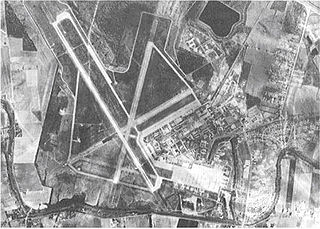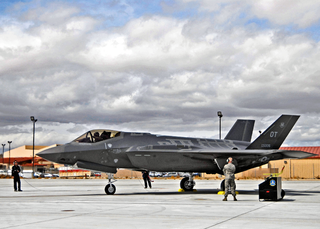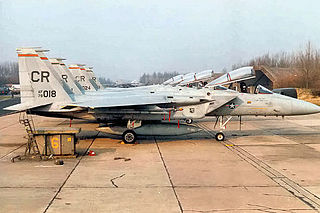32d Air Expeditionary Group  | |
|---|---|
 McDonnell Douglas F-15C Eagles of the 32d Tactical Fighter Group | |
| Active | 1941–1943, 1948–1949, 1957–1962, 1989–2006 |
| Country | United States |
| Branch | |
| Role | Expeditionary Operations |
| Part of | United States Air Forces Europe |
| Decorations | Air Force Outstanding Unit Award |
| Insignia | |
| 32d Air Expeditionary Group emblem (approved 8 August 1960) [1] |  |
The 32d Air Expeditionary Group is a provisional unit of the United States Air Force (USAF). It is assigned to United States Air Forces in Europe (USAFE) to activate or inactivate at any time. [2] It was last active as the 32d Air And Space Operations Center in December 2006 at Ramstein Air Base, Germany. [2]
Contents
- Mission
- History
- World War II
- Reconnaissance in the Far East
- Air Defense of the United States
- Tactical Fighters
- NATO Support in Europe
- Lineage
- Assignments
- Stations
- Component Units
- Aircraft
- Awards and campaigns
- See also
- References
- Notes
- Citations
- Bibliography
- External links
The group was first activated in 1940 at Rio Hato Army Air Base, Panama as the 32d Pursuit Group to provide air defense for the Panama Canal Zone. It continued in this mission until 1943, when the perceived threat of an attack on the Panama Canal decreased and the group, by then the 32d Fighter Group, was disbanded. As Air Defense Command expanded its defenses during the Cold War against possible Soviet attack with units stationed along the northern border of the United States, the group was revived in February 1957 at Minot Air Force Base, North Dakota. As Minot facilities expanded to accommodate Strategic Air Command (SAC) units there, a larger organization was required to manage the station and the group was inactivated and replaced by the 32d Fighter Wing.
The 32d Composite Wing was activated at Kadena Air Base, Okinawa in August 1948 as part of the Air Force's wing base reorganization. The wing conducted reconnaissance missions in the Far East with squadrons attached from other units. It continued its mission for only eight months, then it was inactivated and its personnel were transferred to the newly organized 6332d Station Wing. The 32d Wing was redesignated the 32d Fighter Wing and replaced the group in February 1961 as the host organization at Minot Air Force Base. However, it soon became apparent that Minot's support for the increasing SAC presence there called for the transfer of host responsibility to SAC and the wing was discontinued in July 1962. The wing was briefly active in 1964 as the 32d Tactical Fighter Wing at George Air Force Base, California in 1964, but was soon inactivated when the 8th Tactical Fighter Wing transferred on paper from Pacific Air Forces to Tactical Air Command and took over its role at George.
In 1984, the group and wing were consolidated into a single unit. As the 32d Tactical Fighter Group, the consolidated unit was activated at Soesterberg Air Base, Netherlands, where its 32d Tactical Fighter Squadron had been active since 1955. It served as a fighter group at Soesterberg until 1994, when USAFE reduced its fighter forces at the end of the Cold War. It moved to Ramstein Air Base, Germany and became the air and space operations center for USAFE as the 32d Air Operations Group. It served in this role until 2006, when its personnel and equipment were transferred to the new 603d Air and Space Operations Center.
The group was converted to provisional status in early 2011 as the 32d Air Expeditionary Group and assigned to USAFE to activate and inactivate as needed for contingency operations.






























